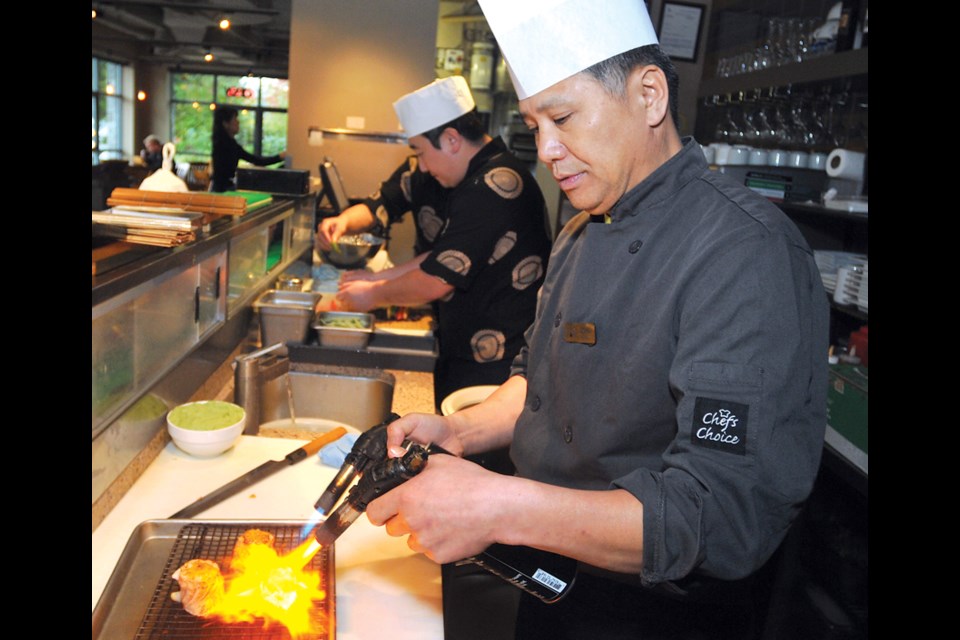Irassharu is a particularly polite verb in Japanese, referring only to others (never oneself) and can mean, depending on the context, to go, to come, or to exist.
In its honourific form, directed to someone with whom one is not well acquainted, the verb is conjugated as irasshaimase (“ee-ras-shy-mas-eh”). This is what you hear when you enter a Japanese restaurant; it is usually shouted enthusiastically by the kitchen and often by the front-of-house staff too.
The term has come to mean “come on in, welcome”. It is pronounced in such an emphatic, boisterous way in order to indicate to the customer that the staff of the restaurant has mobilized and is ready to serve.
As I walked into Momiji Japanese Cuisine late one recent rainy weeknight, the greeting was particularly exuberant, echoing through the otherwise quiet space like a battle cry on a sprawling field.
Dining alone, I opted to sit at the sushi bar located just inside the main door. This is typically my favourite seat in the house in any sushi joint, as I love to watch the chefs at work, deftly wielding their surgically-sharp Damascus steel blades and communicating with each other through practiced, intuitive motions more than words.
The chef behind the sushi bar (who, I discovered through conversation later in my meal, was Momiji executive chef and owner John Cheong) took my order directly, quietly relaying instructions to his sous-chef and to the nearby kitchen.
My meal began with two pieces of uni nigiri, fresh sea urchin roe set atop nori-wrapped rice.
It is the beginning of sea urchin season now, and one of my favourite times of year as a result, but I will spare the regular reader my usual rhapsodic tribute to this Pacific Northwest treasure this time; let it suffice to say that the uni was very fresh and enjoyable enough to compel me to order one additional piece at the end of my meal as dessert.
Next up was a duo of tuna nigiri, prepared in the de rigueur aburi style, meaning the fish is lightly torched before it is served, bringing natural oils and aromas to the surface and raising the temperature of the morsel slightly.
Quite often aburi sushi is garnished with unconventional, “new world” flare like chillies, lime, or cilantro; this is probably a nod to the progressive, contemporary Peruvian style of sushi made famous by renowned chefs like Nobuyuki Matsuhisa. Here, it was topped with pureed ginger and scallion.
One general observation applicable to most of what I ate is that Momiji’s portions are very generous; the aburi tuna morsels were cut long and wide, still manageable as a one-bite affair, but certainly not dainty.
My next course, Hamachi sashimi, was similarly well-portioned with five thick-cut triangles of exceptionally fresh fish. Hamachi is often called yellowtail tuna, but is not, in fact, in the tuna family at all; it belongs to the jack fish species.
The sashimi was elegantly served atop a bed of finely crushed ice and minimally accompanied by pale, thinly sliced ginger, wasabi, a round of lemon and a bouquet of pea shoots.
My other observation about Cheong’s cuisine is that it is generally colourful and artfully presented.
On his recommendation, I tried the Aburi Salmon Fire Roll, featured on the menu’s panel of specialty rolls, all of which afford the chef the opportunity to flex his creative muscle.
The roll in question was comprised of tempura prawns, crab and avocado wrapped tightly in rice and nori, generously topped with a layer of salmon and garlic mayo, seared dramatically with two blowtorches, topped with a spoonful of bright red tobiko, sliced, and then set atop a thin pond of teriyaki sauce. The slices of the roll were arranged in a circle around a simple mound of greens and pea shoots.
Cheong, who has worked for more than 25 years as a sushi chef, including a considerable stint working with accomplished Vancouver sushi master Yoshi Tabo, explained to me that the relentless fascination with tuna and salmon among local diners has prompted him to push the boundaries of creativity using those items as the focus, rather than trying to introduce new and unusual fish.
Cheong explains that in his experience unless a sushi restaurant is committed to a high-end, niche audience, most diners are not all that keen on the unfamiliar textures and flavours that often mark other fish widely used in Japan.
I am pleased to report that while the specialty rolls on Momiji’s menu are indeed fun and creative, they are not gimmicky; at their core, they are based on proven combinations of flavours and textures.
When my Fire Roll arrived, I was relieved to see that it had not been set aflame as some piece of edible theatre.
An amply portioned piece of unagi (barbecued eel) nigiri accompanied my sea urchin “dessert”.
My meal, which included a small bottle of Kirin and an order of hot sake, was $56 before gratuity.
Momiji (which means maple leaves, incidentally) is located at 3720 Mount Seymour Parkway. 604-929-0990
Chris Dagenais served as a manager for several restaurants downtown and on the North Shore. He earned his sommelier diploma in 2001. He can be reached via email at [email protected]. North Shore News dining reviews are conducted anonymously and all meals are paid for by the newspaper.



